#this design is moreso for the third arc and beyond
Explore tagged Tumblr posts
Text

Happy Birthday Minako Aino!!
feat her ITNOTM design!
#my art#art#sailor moon#artists on tumblr#digital art#in the name of the moon#itnotm#been trying to upload this all day#the tumblr app is inept#this design is moreso for the third arc and beyond#when she has joy and whimsy#redesign#sailor moon redesign#minako aino#sailor venus#y2k#kinda
23 notes
·
View notes
Note
Hello!! Good morning or night or evening or afternoon or whatever it is where you live!!What do you want to happen in Fionna and cake season 2?? Like what aspects of the original series and of season one do you want to get further explored?
OHH MYGOD THANK U. HI HIHI HIII HELLO. :3 yapping ahead
UMM OK SO. personally i imagine that s2 will be either an anthology thing with each episode focusing on different mainworld or alt universe guys + fionna and cake, OR, someone will replace simon as the kind of third main character. simon’s arc is pretty wrapped up and i would love to see finn and fionna adventuring together actually !! however i feel like finn will not be a main character beyond maybe an episode or smth bc his main thing rn is how very clearly not good hes doing after jakes death + in denial about it but in together again we see that never really went away and he was always sort of waiting to see him again after death !! so any sort of a healing arc would kinda contradict that so idk !!
speaking of simon PLEASEEE give us simon and marcy moments PLEASE i was a teensy bit baffled that she was not shown in simons little happy ending healing going to therapy etc montage. we got like 15 seconds of drunk bubbline in episode 2 😭 also this is just me personally but simon and pb have the potential to be so fucking funny the in laws of all time…
im reallyy torn on whether fionna will lose her arm bc on one hand the universe is canonized now and its a canon event of sorts for all finn adjacent timelines and past lives BUT fionna ISNT a varient of him exactly a wish didnt split a new timeline like farmworld, shes created by prismo and just unintentionally inspired by finn ! so im not sure which direction the writers will go but i would think not bc shes not directly tied to his fate if that makes sense
im also quite interested to see more of fionnaworld with magic. tbh its been a bit since i watched the finale and i dont remember exact details on that to theorize rn 😭 im sure we’ll see more of jay, little destiny, i miiight be misremembering but wasnt baby finn there at the end 😭 i think this season will have less universe hopping bc theyre not running but we may see the others in farmworld etc
on one hand i desperately want to see betty BUT i know her story is kind of over and if they undo it that would be really stupid. also i have my gripes with how they wrote some of her stuff im season one but thats. another post LMAO. the best i can hope for atp is a cameo i think. betty cameo save me. save me betty cameo
hmm more characters i wanna see,,, bmo ofc always but also i think a good chunk of mainworld characters without jake will make me sad 😭 susan and frieda would be awesomesauce… lesbians… magic man as well i think he and simon should hang out… HUNTRESS WIZARD… also flame princess just occurred to me bc shes the only princess who seems to like? age? so maybe she’d have a new design :3 more finn + island humans content like with the minerva bots…
OK i think im at the point where this will stop making sense soon bc my brains real empty rn, i have less actual theories that i can remember off the top of my head and moreso just me yapping but ! THANK U FOR THE ASK HOPE U HAVE A GOOD DAY TOO ^_^
6 notes
·
View notes
Text
ESSAY: Berserk's Journey of Acceptance Over 30 Years of Fandom
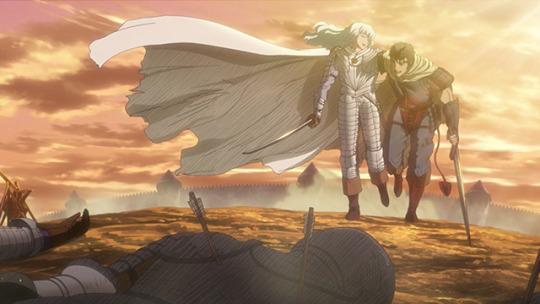
My descent into anime fandom began in the '90s, and just as watching Neon Genesis Evangelion caused my first revelation that cartoons could be art, reading Berserk gave me the same realization about comics. The news of Kentaro Miura’s death, who passed on May 6, has been emotionally complicated for me, as it's the first time a celebrity's death has hit truly close to home. In addition to being the lynchpin for several important personal revelations, Berserk is one of the longest-lasting works I’ve followed and that I must suddenly bid farewell to after existing alongside it for two-thirds of my life.
Berserk is a monolith not only for anime and manga, but also fantasy literature, video games, you name it. It might be one of the single most influential works of the ‘80s — on a level similar to Blade Runner — to a degree where it’s difficult to imagine what the world might look like without it, and the generations of creators the series inspired.
Although not the first, Guts is the prototypical large sword anime boy: Final Fantasy VII's Cloud Strife, Siegfried/Nightmare from Soulcalibur, and Black Clover's Asta are all links in the same chain, with other series like Dark Souls and Claymore taking clear inspiration from Berserk. But even deeper than that, the three-character dynamic between Guts, Griffith, and Casca, the monster designs, the grotesque violence, Miura’s image of hell — all of them can be spotted in countless pieces of media across the globe.
Despite this, it just doesn’t seem like people talk about it very much. For over 20 years, Berserk has stood among the critical pantheon for both anime and manga, but it doesn’t spur conversations in the same way as Neon Genesis Evangelion, Akira, or Dragon Ball Z still do today. Its graphic depictions certainly represent a barrier to entry much higher than even the aforementioned company.
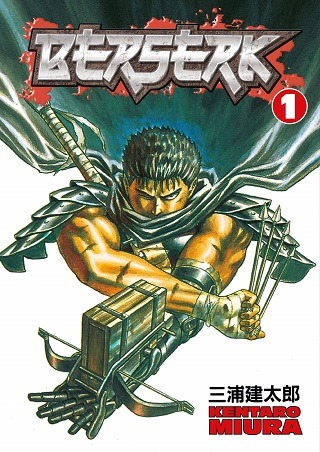
Seeing the internet exude sympathy and fond reminiscing about Berserk was immensely validating and has been my single most therapeutic experience online. Moreso, it reminded me that the fans have always been there. And even looking into it, Berserk is the single best-selling property in the 35-year history of Dark Horse. My feeling is that Berserk just has something about it that reaches deep into you and gets stuck there.
I recall introducing one of my housemates to Berserk a few years ago — a person with all the intelligence and personal drive to both work on cancer research at Stanford while pursuing his own MD and maintaining a level of physical fitness that was frankly unreasonable for the hours that he kept. He was NOT in any way analytical about the media he consumed, but watching him sitting on the floor turning all his considerable willpower and intellect toward delivering an off-the-cuff treatise on how Berserk had so deeply touched him was a sight in itself to behold. His thoughts on the series' portrayal of sex as fundamentally violent leading up to Guts and Casca’s first moment of intimacy in the Golden Age movies was one of the most beautiful sentiments I’d ever heard in reaction to a piece of fiction.
I don’t think I’d ever heard him provide anything but a surface-level take on a piece of media before or since. He was a pretty forthright guy, but the way he just cut into himself and let his feelings pour out onto the floor left me awestruck. The process of reading Berserk can strike emotional chords within you that are tough to untangle. I’ve been writing analysis and experiential pieces related to anime and manga for almost ten years — and interacting with Berserk’s world for almost 30 years — and writing may just be yet another attempt for me to pull my own twisted-up feelings about it apart.
Berserk is one of the most deeply personal works I’ve ever read, both for myself and in my perception of Miura's works. The series' transformation in the past 30 years artistically and thematically is so singular it's difficult to find another work that comes close. The author of Hajime no Ippo, who was among the first to see Berserk as Miura presented him with some early drafts working as his assistant, claimed that the design for Guts and Puck had come from a mess of ideas Miura had been working on since his early school days.
写真は三浦建太郎君が寄稿してくれた鷹村です。 今かなり感傷的になっています。 思い出話をさせて下さい。 僕が初めての週刊連載でスタッフが一人もいなくて困っていたら手伝いにきてくれました。 彼が18で僕が19です。 某大学の芸術学部の学生で講義明けにスケッチブックを片手に来てくれました。 pic.twitter.com/hT1JCWBTKu
— 森川ジョージ (@WANPOWANWAN) May 20, 2021
Miura claimed two of his big influences were Go Nagai’s Violence Jack and Tetsuo Hara and Buronson’s Fist of the North Star. Miura wears these influences on his sleeve, discovering the early concepts that had percolated in his mind just felt right. The beginning of Berserk, despite its amazing visual power, feels like it sprang from a very juvenile concept: Guts is a hypermasculine lone traveler breaking his body against nightmarish creatures in his single-minded pursuit of revenge, rigidly independent and distrustful of others due to his dark past.
Uncompromising, rugged, independent, a really big sword ... Guts is a romantic ideal of masculinity on a quest to personally serve justice against the one who wronged him. Almost nefarious in the manner in which his character checked these boxes, especially when it came to his grim stoicism, unblinkingly facing his struggle against literal cosmic forces. Never doubting himself, never trusting others, never weeping for what he had lost.
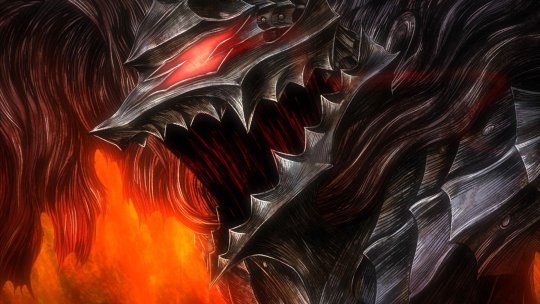
Miura said he sketched out most of the backstory when the manga began publication, so I have to assume the larger strokes of the Golden Arc were pretty well figured out from the outset, but I’m less sure if he had fully realized where he wanted to take the story to where we are now. After the introductory mini-arcs of demon-slaying, Berserk encounters Griffith and the story draws us back to a massive flashback arc. We see the same Guts living as a lone mercenary who Griffith persuades to join the Band of the Hawk to help realize his ambitions of rising above the circumstances of his birth to join the nobility.
We discover the horrific abuses of Guts’ adoptive father and eventually learn that Guts, Griffith, and Casca are all victims of sexual violence. The story develops into a sprawling semi-historical epic featuring politics and war, but the real narrative is in the growing companionship between Guts and the members of the band. Directionless and traumatized by his childhood, Guts slowly finds a purpose helping Griffith realize his dream and the courage to allow others to grow close to him.
Miura mentioned that many Band of the Hawk members were based on his early friend groups. Although he was always sparse with details about his personal life, he has spoken about how many of them referred to themselves as aspiring manga authors and how he felt an intense sense of competition, admitting that among them he may have been the only one seriously working toward that goal, desperately keeping ahead in his perceived race against them. It’s intriguing thinking about how much of this angst may have made it to the pages, as it's almost impossible not to imagine Miura put quite a bit of himself in Guts.
Perhaps this is why it feels so real and makes The Eclipse — the quintessential anime betrayal at the hands of Griffith — all the more heartbreaking. The raw violence and macabre imagery certainly helped. While Miura owed Hellraiser’s Cenobites much in the designs of the God Hand, his macabre portrayal of the Band of the Hawk’s eradication within the literal bowels of hell, the massive hand, the black sun, the Skull Knight, and even Miura’s page compositions have been endlessly referenced, copied, and outright plagiarized since.
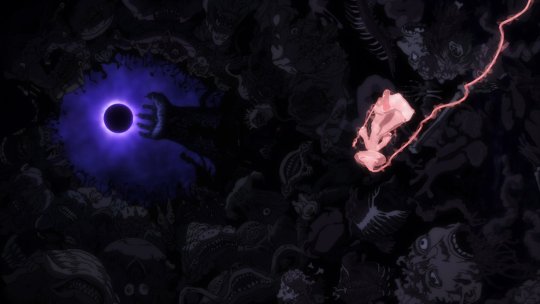
The events were tragic in any context and I have heard many deeply personal experiences others drew from The Eclipse sympathizing with Guts, Casca, or even Griffith’s spiral driven by his perceived rejection by Guts. Mine were most closely aligned with the tragedy of Guts having overcome such painful circumstances to not only reject his own self enforced solitude, but to fearlessly express his affection for his loved ones.
The Golden Age was a methodical destruction of Guts’ self-destructive methods of preservation ruined in a single selfish act by his most trusted friend, leaving him once again alone and afraid of growing close to those around him. It ripped the romance of Guts’ mission and eventually took the story down a course I never expected. Berserk wasn’t a story of revenge but one of recovery.
Guess that’s enough beating around the bush, as I should talk about how this shift affected me personally. When I was young, when I began reading Berserk I found Guts’ unflagging stoicism to be really cool, not just aesthetically but in how I understood guys were supposed to be. I was slow to make friends during school and my rapidly gentrifying neighborhood had my friends' parents moving away faster than I could find new ones. At some point I think I became too afraid of putting myself out there anymore, risking rejection when even acceptance was so fleeting. It began to feel easier just to resign myself to solitude and pretend my circumstances were beyond my own power to correct.
Unfortunately, I became the stereotypical kid who ate alone during lunch break. Under the invisible expectations demanding I not display weakness, my loneliness was compounded by shame for feeling loneliness. My only recourse was to reveal none of those feelings and pretend the whole thing didn't bother me at all. Needless to say my attempts to cope probably fooled no one and only made things even worse, but I really didn’t know of any better way to handle my situation. I felt bad, I felt even worse about feeling bad and had been provided with zero tools to cope, much less even admit that I had a problem at all.
The arcs following the Golden Age completely changed my perspective. Guts had tragically, yet understandably, cut himself off from others to save himself from experiencing that trauma again and, in effect, denied himself any opportunity to allow himself to be happy again. As he began to meet other characters that attached themselves to him, between Rickert and Erica spending months waiting worried for his return, and even the slimmest hope to rescuing Casca began to seed itself into the story, I could only see Guts as a fool pursuing a grim and hopeless task rather than appreciating everything that he had managed to hold onto.
The same attributes that made Guts so compelling in the opening chapters were revealed as his true enemy. Griffith had committed an unforgivable act but Guts’ journey for revenge was one of self-inflicted pain and fear. The romanticism was gone.
Farnese’s inclusion in the Conviction arc was a revelation. Among the many brilliant aspects of her character, I identified with her simply for how she acted as a stand-in for myself as the reader: Plagued by self-doubt and fear, desperate to maintain her own stoic and uncompromising image, and resentful of her place in the world. She sees Guts’ fearlessness in the face of cosmic horror and believes she might be able to learn his confidence.

But in following Guts, Farnese instead finds a teacher in Casca. In taking care of her, Farnese develops a connection and is able to experience genuine sympathy that develops into a sense of responsibility. Caring for Casca allows Farnese to develop the courage she was lacking not out of reckless self-abandon but compassion.
I can’t exactly credit Berserk with turning my life around, but I feel that it genuinely helped crystallize within me a sense of growing doubts about my maladjusted high school days. My growing awareness of Guts' undeniable role in his own suffering forced me to admit my own role in mine and created a determination to take action to fix it rather than pretending enough stoicism might actually result in some sort of solution.
I visited the Berserk subreddit from time to time and always enjoyed the group's penchant for referring to all the members of the board as “fellow strugglers,” owing both to Skull Knight’s label for Guts and their own tongue-in-cheek humor at waiting through extended hiatuses. Only in retrospect did it feel truly fitting to me. Trying to avoid the pitfalls of Guts’ path is a constant struggle. Today I’m blessed with many good friends but still feel primal pangs of fear holding me back nearly every time I meet someone, the idea of telling others how much they mean to me or even sharing my thoughts and feelings about something I care about deeply as if each action will expose me to attack.
It’s taken time to pull myself away from the behaviors that were so deeply ingrained and it’s a journey where I’m not sure the work will ever be truly done, but witnessing Guts’ own slow progress has been a constant source of reassurance. My sense of admiration for Miura’s epic tale of a man allowing himself to let go after suffering such devastating circumstances brought my own humble problems and their way out into focus.
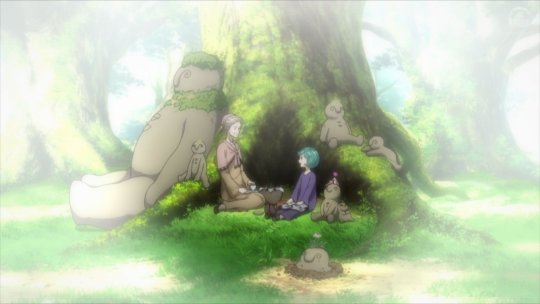
Over the years I, and many others, have been forced to come to terms with the fact that Berserk would likely never finish. The pattern of long, unexplained hiatuses and the solemn recognition that any of them could be the last is a familiar one. The double-edged sword of manga largely being works created by a single individual is that there is rarely anyone in a position to pick up the torch when the creator calls it quits. Takehiko Inoue’s Vagabond, Ai Yazawa’s Nana, and likely Yoshihiro Togashi’s Hunter X Hunter all frozen in indefinite hiatus, the publishers respectfully holding the door open should the creators ever decide to return, leaving it in a liminal space with no sense of conclusion for the fans except what we can make for ourselves.
The reason for Miura’s hiatuses was unclear. Fans liked to joke that he would take long breaks to play The Idolmaster, but Miura was also infamous for taking “breaks” spent minutely illustrating panels to his exacting artistic standard, creating a tumultuous release schedule during the wars featuring thousands of tiny soldiers all dressed in period-appropriate armor. If his health was becoming an issue, it’s uncommon that news would be shared with fans for most authors, much less one as private as Miura.
Even without delays, the story Miura was building just seemed to be getting too big. The scale continued to grow, his narrative ambition swelling even faster after 20 years of publication, the depth and breadth of his universe constantly expanding. The fan-dubbed “Millennium Falcon Arc” was massive, changing the landscape of Berserk from a low fantasy plagued by roaming demons to a high fantasy where godlike beings of sanity-defying size battled for control of the world. How could Guts even meet Griffith again? What might Casca want to do when her sanity returned? What are the origins of the Skull Knight? And would he do battle with the God Hand? There was too much left to happen and Miura’s art only grew more and more elaborate. It would take decades to resolve all this.
But it didn’t need to. I imagine we’ll never get a precise picture of the final years of Miura’s life leading up to his tragic passing. In the final chapters he released, it felt as if he had directed the story to some conclusion. The unfinished Fantasia arc finds Guts and his newfound band finding a way to finally restore Casca’s sanity and — although there is still unmistakably a boundary separating them — both seem resolute in finding a way to mend their shared wounds together.
One of the final chapters features Guts drinking around the campfire with the two other men of his group, Serpico and Roderick, as he entrusts the recovery of Casca to Schierke and Farnese. It's a scene that, in the original Band of the Hawk, would have found Guts brooding as his fellows engage in bluster. The tone of this conversation, however, is completely different. The three commiserate over how much has changed and the strength each has found in the companionship of the others. After everything that has happened, Guts declares that he is grateful.
The suicidal dedication to his quest for vengeance and dispassionate pragmatism that defined Guts in the earliest chapters is gone. Although they first appeared to be a source of strength as the Black Swordsman, he has learned that they rose from the fear of losing his friends again, from letting others close enough to harm him, and from having no other purpose without others. Whether or not Guts and Griffith were to ever meet again, Guts has rediscovered the strength to no longer carry his burdens alone.
All that has happened is all there will ever be. We too must be grateful.
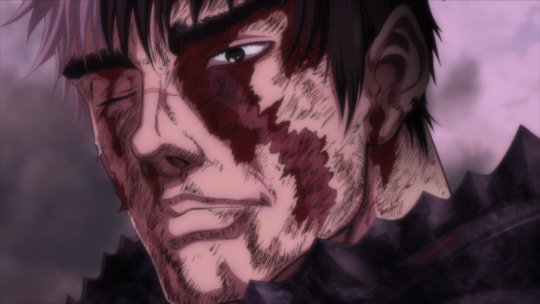
Peter Fobian is an Associate Manager of Social Video at Crunchyroll, writer for Anime Academy and Anime in America, and an editor at Anime Feminist. You can follow him on Twitter @PeterFobian.
By: Peter Fobian
4 notes
·
View notes
Text
Umineko Post-Arc-4 Theorypost
Um. Wow. Okay. So I just finished Umineko’s fourth arc, and that was A Lot wow. Anyway, at this point I want to do an Umineko theorypost, inspired by my vague recollection that @itsbenedict (whose recommendation was what got me to start actively working through the game rather than just idly having it on my to-play-eventually pile) did one when he reached this point in the story. I figure it could be pretty fun to compare my notes from this point in the story with his, once I’ve gotten to the end and don’t need to worry about spoilers.
So here’s my theorypost, then. Below the break: major Umineko spoilers, as well as some incidental Higurashi spoilers.
Let’s start with the magic system, and let’s divide it into two broad categories: magic in the actual world, and magic in meta-space. The first sort includes summoning minions, reviving the dead, et cetera. The second sort includes being able to speak in red and blue, to cause something to cease to exist by arguing sufficiently persuasively for its nonexistence, to time-loop the island, et cetera.
Magic in the actual world seems pretty clearly at this point to run on a mix of imagination, deceptive scene-setting, and unreliable narration; but meta-space magic seems to run on less consistent rules. The time-looping seems like it ultimately boils down to unreliable narration as well, with the stories-in-bottles, and speaking in blue isn’t actually overtly magical (aside from the bit where it directly injures Beatrice, which is a similar sort of mystery to the red’s ability to render people or things nonexistent), but speaking in red seems pretty unambiguously magical in a fashion whose true explanation I haven’t yet figured out. I expect an explanation to eventually arise in the form of some sort of actually-authoritative source on the events emerging, but I’m not yet sure what form that source will take, because I’m not sure how a mundane source could be as trustworthy as the red seems to be.
Next up: the witch’s riddle. Clearly solvable, and I suspect that had I been cleverer I’d have been able to solve it based on the discussion in the third game and the knowledge that the solution is reachable through that discussion; but I haven’t, in fact, solved it myself. It seems likely that the solution involves Kuwadorian in some capacity, because “solving the riddle involves finding Kuwadorian” seems more likely than Eva having solved both of those mysteries independently (and she does need to have solved the Kuwadorian mystery, she couldn’t have lied about that, because if she’d gone “I was hiding in the extra hidden mansion deep in the forest, but I can’t show you where it is” she would have come across as even more suspicious to the investigators than she in fact did.) I lack clear hypotheses, beyond that.
One detail that struck me about the fourth game in particular is that there are a lot of weird weapons flying around. We’ve got the golden thread attested to by Gohda and Kumasawa and Kyrie, we’ve got whatever it was that pit-trapped everyone in the dining room, we’ve got whatever Kanon used to cut through the bars... and, of course, there are the Seven Stakes of Purgatory, which are somewhat less mysterious in that they could easily just be fancy mundane stakes, but are still indicative of the general trend of nonstandard weapons around the island, with no obvious leads on where exactly they came from. It’s very possible that all of these weapons are unrelated to one another, but it’s also occurred to me as a possibility that there may be some sort of designer of fancy custom weaponry, off of the island but contributing resources to one or more of the parties involved here. This is a pretty weak hypothesis as far as they go, like I only give it maybe 10% odds of actually being true, but I figure it’s still worth mentioning.
Moving on to specific characters:
Kinzo is dead. It’s unclear where his corpse has been being kept, but it has to have been refrigerated in some capacity in order to avoid either decomposing excessively or smelling up the house prior to its being burnt, so that limits the possibilities somewhat. Nanjo and Genji are definitely in on the his-being-dead part, and Krauss probably is as well. Nanjo, at least, is in on the his-corpse-being-preserved part as well, given that he never expresses confusion over finding the corpse in the boiler.
Battler’s theory that someone has taken on Kinzo’s name seems off in a similar fashion to his theory that someone had taken on Kanon’s name, even if it wasn’t explicitly denied like the other theory was; but in absence of any better ideas about what’s going on there I’m tentatively subscribing it for now.
My current top suspect for who’s acting in Kinzo’s place is Genji, because he’s the only one who evidence suggests that Kinzo genuinely trusted and who would be able to persuade others to accept him as acting as Kinzo without the siblings’ squabbles leading them to try to sabotage his authority. (Nanjo, although also trusted by Kinzo in some capacity, seems much more in-the-dark about parts like the mass-sacrifice stuff and less likely to be accepted as The New Kinzo by the siblings.)
This theory may or may not be hindered by the red truth that Genji isn’t a killer, because it’s unclear if that was a general comment or if it was made specifically about the Genji of the first game; but even assuming it holds across all four games, it seems plausibly loopholable by way of his having others do the killing for him. This would require some way of tricking or persuading Gohda and Kumasawa into reporting both him and Kinzo as separately present at the conference in the fourth game, and reporting him as having been killed; but that’s a problem that every other plausible candidate would have as well, since everyone not in the cousin room was (reportedly) at the conference, so it’s not a problem specific to Genji.
Nanjo remains a mystery thus far. There’s no way he’s unaware of Kinzo’s death, and I get general vibes of suspiciousness off of him in light of his knowing far more than he says about various important Kinzo-related secrets, but there are no specific incidents I feel any particular inclination to pin on him, just a general sense of “he’s plausibly an accomplice to some of the stuff going on”. He’s in a similar not-a-killer-but-maybe-only-in-the-context-of-the-first-game-it’s-unclear boat to Genji.
Kumasawa is also a mystery thus far. Her tendency to try to run from danger leaves open the possibility of her doing things in secret while nobody has eyes on her; but unlike Genji and Nanjo she lacks the degree of clear closeness to Kinzo that would mark her as particularly suspicious. She definitely has something more going on than is currently clear, especially in light of her connection to Virgilia (more on that later), but for the moment my thoughts about her are pretty fuzzy and vaguely-formed.
Gohda, by contrast, I’m relatively willing to trust as being basically who he’s presented as. Likes cooking, likes showing off, dislikes being in danger, prone to petty obnoxiousness against the other servants, but he’s not in Kinzo’s inner circle and he lacks any obvious motive for involvement in the murders. Maybe there are subtle cues of suspiciousness I’m missing, but for the time being, I’m inclined to class him as among the most straightforward and easy-to-understand of the characters.
Kanon and Shannon are in Kinzo’s inner circle at least somewhat, if less closely than Genji, and most likely know things they haven’t shared (even if I don’t know what things specifically). Moreso than any of the other servants, they’re actively working against the murders happening, and have clear motives for doing so with their respective romantic interest in Jessica and George. While they have some amount of motive for knocking off disapproving guardians in particular, none of the bunches of murders that happen resemble what such an attempt would look like, and so I’m pretty confident they’re not doing that and are instead relatively straightforwardly on the murder-is-bad-actually side of things.
Also, they have magic. I mean, not really, but they do things mysterious enough that they seem like they have magic, and with the fourth game’s proverbial spilling-ink-on-the-white-squares their magic can no longer be chalked up entirely to unreliable narration, because testimony of it managed to reach Battler through Kyrie’s call. Shannon spent most of her time shielding against threats invisible to everyone else, such that her seeming magic is relatively easy to dismiss; but Kanon, with his ability to cut through the various bars in their way using something that looks like a glowy red blade, is harder to explain. I’m stumped on that one for the time being, assuming the implausible custom-weapon-designer hypothesis is false.
Krauss knows things. Among the characters who Kinzo distrusted, I suspect him to be the best-informed, if still not actually all that well-informed relative to Kinzo’s inner circle, about Kinzo’s various machinations; he knows that the gold is real, he most likely knows about Kinzo’s death (and, if he doesn’t, he definitely at least heavily suspects), he knows that the servants are in on Kinzo’s plans, et cetera. That said, it’s not clear how much more beyond that he does or doesn’t know.
He’s one of the first to be killed in the first two arcs, and honestly has much less incentive for murder than any of his siblings given his being the current top contender for the succession, so I’m inclined to trust that he’s not one of the murderers.
I’m not all that confident in my read on Natsuhi, but for the moment, I’m inclined to take her as at least moderately suspicious. Unlikely to be the sole murderer in any of the games, but potentially one of the murderers. The first game, in particular, gives her a clear motive, with her fight with Krauss over the gold being followed with (a) his death and (b) her grab for power by way of visiting Kinzo’s study and then beginning to present herself as his successor. Supporting this is the detail that, in the third game, she was gouged with the Stake of Satan, which while not a super reliable metric of what’s up with her is definitely at least a tick in favor of anger being a thing that motivates her, which fits with Krauss being among the first twilight’s victims in the game wherein she was particularly angered.
Eva is, while probably not the sole murderer in the third game, most likely at least one of them. (Not the sole murderer for two reasons: first, Nanjo’s death while she was occupied shooting Battler; second, George and Hideyoshi’s deaths, which don’t line up either with her love for Hideyoshi (which is pretty unambiguously genuine) or her desire to make George her successor.) She had means (with Hideyoshi’s covering for her and making openings), she had motive (the gold she’d found), she was the sole survivor of the incident, and just generally all evidence suggests her culprithood.
Hideyoshi, assuming that the Eva-as-third-game-murderer hypothesis is correct, was her accomplice. More generally, despite his tendency to deescalate the sibling-fights, he’s pretty firmly in her corner when it comes to wanting the money and wanting George to be the successor. I’m thus inclined to mostly treat the pair of them as a unit, and assume that important information known by one is known by the other as well, although it’s not clear for the moment that either of them does know much in the way of important information, outside of the case where Eva managed to find the gold.
Rudolf has mostly not had much chance to show us what’s up with him, having died on the first twilight in three of the four games and not accomplished all that much prior to his death in the remaining one. Probably the most striking thing that happened with him was his confidence, in the first game, that he would be murdered that night, as he in fact was; while he framed it at the time just in terms of the inheritance dispute of the moment, it seems plausible, in light of Beatrice’s story about his making some play six years ago that involved Battler in some capacity and ultimately led to all the murders happening, that that play of his was the true reason he was worried. Sadly, I have very little idea what he actually did back then, beyond “probably something, unless Beatrice was lying about something important having happened then, which I can’t totally write off as a possibility”.
Kyrie is the most overtly prone to Plotting of the bunch, but nonetheless seems pretty non-suspicious for the time being; when she’s not killed on the first twilight, she seems pretty genuine about turning her Plotting skills towards not dying, rather than infighting. Furthermore, she lacks any obvious motive for any of the murders that happen while she’s alive, and plenty of motive for making Rudolf’s murder in particular not happen. Thus I’m inclined to trust her.
Rosa is the single most suspicious person in the whole cast. In the second game, when she’s the one leading the survivors, she tosses around so much suspicion and paranoia-building that she comes across as deliberately sabotaging them. In the third game, she’s the one non-Eva person who’s found the gold, making her an obvious suspect there too, albeit less so than in the second given her death. I don’t think she’s the sole murderer of the second game, given that it ends with her being chomped by demons rather than escaping with the gold the way she’s trying to do, but she’s definitely among the more significant suspects. Oh, and let’s also toss in her history with Beatrice onto the reasons-to-suspect-her pile for good measure, because her “but I killed you!” rant just before her death in the third game didn’t make it seem like she was being entirely truthful about her “she fell off a cliff in a manner that I was moderately at fault for” story during the siblings’ conference, and thus she may well have a history of murder.
Jessica is another of the characters who I haven’t got a great read on. She likes Kanon, she’s rebellious towards but ultimately loves her parents, she gets Very Angry when people she cares about are murdered, and... that’s about all I’ve got. She seems pretty safe on the not-being-a-murderer front, but my sense of what’s actually going on with her is nongreat.
George is also probably not one of the murderers, but he’s at least not a complete write-off as a suspect in the way that Jessica is, given his level of martial-arts competence and his determination to fight Literally Everyone if they try to get between him and Shannon. Still, in practice there’s no evidence that anyone actually tripped over his Fight Everyone plan in that regard, and he doesn’t strike me as the type to preemptively do murders before being challenged, so I’m inclined to write him off on the basis of his lacking a motive.
Battler... has some interesting backstory stuff going on, with the reveal of his possibly being not the original Battler at all. For the time being, I’m inclined to continue trusting him as the Central Viewpoint Character Whose Observations Define The Boundaries Of Which Mysteries Need Explaining, since that role kind of inherently precludes his having seen the murders happen; but if Gameboard!Battler and Meta!Battler turn out to be more divergent than I currently believe them to be then I’ll have to revise that assessment.
Maria is, of the cousins, by far the most suspicious, and the only one who I genuinely think might be one of the murderers in some of the games. She has all these spells made for murder-related purposes, she explicitly has plans to kill the witch possessing Rosa (who is, of course, really Rosa herself), she’s allied with Beatrice, et cetera. Lots of points of suspicion. One particularly suspicious incident is Rosa’s death in the third game, given the two of them having been alone together; I’d be pretty non-shocked by her being the murderer there.
And then we come to Beatrice herself, who is by far the most mysterious member of the cast. According to Rosa’s testimony, she killed someone who looked just like the Beatrice of the portrait during her childhood, long before the events of the game; Captain Kawabata’s story about deliveries to Kuwadorian suddenly halting about thirty years ago (eighteen years prior to the main plot) seem to corroborate this. And yet Beatrice is able to show herself directly to Battler near the end of the fourth game, suggesting that an identical-looking person is alive and furthermore is one of the no-more-than-seventeen people on the island. If we suppose that she’s not secretly one of the seventeen previously-named non-Kinzo characters, then one of them has to be dead as well, which isn’t nearly as plausible as Kinzo’s death because Battler meets all of them at one point or another, so we’ve got to assume furthermore that this person who looks identical to the old dead Beatrice is furthermore actually identical with one of the seventeen.
In terms of pure physical resemblance, Eva is the obvious suspect; they have similar haircuts, and both Beatrice’s dress and Beatrice’s suit conveniently cover up the arm where Eva has the conspicuous tattoo. Their voices differ, as do their manners of speaking, but nonetheless that physical resemblance raises her slightly above the others on my suspicion pile. Her being dead at the time of her would-be interaction with Battler would ordinarily be a significant problem, except that Beatrice explicitly states in red that she’s dead at the time she kills Battler at the end of the fourth game, making it no more of a problem for Eva (being also-dead-at-that-time) than it would be for any of the other possible suspects.
(I have no idea how that particular murder happened, incidentally.)
My other, weirder suspect for Beatrice’s identity is Kumasawa. She’s old enough that I have no idea how she’d pull off the disguise, but she’s good enough at flitting around offscreen that she’s got plenty of opportunity to set scenarios up, and furthermore she’s old enough to possibly be the dead-eighteen-years-ago Beatrice’s implausible identical twin. Honestly I rank this one somewhat higher than I rank the Eva possibility, because while the physical-appearance issue is admittedly tricky, the identical-twin possibility explains some stuff relatively neatly. Under this hypothesis, she��d presumably be exaggerating her age somewhat in her Kumasawa persona, which could potentially explain part of the gap in how-she’d-pull-off-the-disguise. The main challenge to this hypothesis is that she was the third subject of the same ambiguous declaration-in-red of non-killer-ness that Genji and Nanjo were subject to, which in light of Beatrice being confirmed in red to kill Battler at the end of the fourth game means that she can be Beatrice only if that declaration was restricted in scope to the first game only.
So that’s all the humans on the island. I’m going to refrain from talking much about the characters in the Ange flashforward, because for the time being they seem relatively unimportant to the main events of the game; they reveal a bunch of interesting information, with the hundred-million-yen packages they received-but-didn’t-take and with Ange’s exploration of magic having significantly improved my understanding of the rules at play there and so forth, but they don’t have any more direct involvement than that as far as I can tell. Eva’s mysterious resurrection-and-subsequent-death might be another mystery for the pile, or might be just more of the same magic-of-unreliable-narration that drove the rest of the scene in which it took place.
Next up, the various more-inherently-magical figures:
EVA, MARIA, ANGE, and Goldsmith are respectively Eva, Maria, Ange, and Kinzo. Not much more needs to be said here, I think.
Bernkastel and Lambdadelta are respectively Rika and Takano from Higurashi, except not really; they’re clearly related, but Bernkastel is somewhat less straightforwardly benevolent than Rika, and Lambdadelta is pretty different in a few ways from Takano (less creepy, more tsundere, more of a personal rival to Bernkastel where Takano’s relation to Rika was more impersonal, actually has magic beyond High Willpower). I’m not entirely clear on the precise relation there, and mostly it’s tangential to their role here, which is as more-powerful witches who occasionally interfere with Beatrice’s gameboard. They seem to exist exclusively in meta-space, with no direct involvement in the murders.
Sakutaro is a stuffed lion animated with magic (specifically the imagination-based version) in a mostly pretty self-explanatory fashion. The one big interesting thing there is that, judging by the way Beatrice choked on an attempted bit of red text when ANGE was forcing her out of the Golden Land, it seems like Rosa probably made a new vessel for him some time after killing the original (or before, I suppose, although that seems less likely); I’m not sure yet how that’s going to become significant, but I’m pretty sure it is.
Virgilia and Ronove have an interesting link to respectively Kumasawa and Genji. I’m not yet sure of the nature of that link, beyond that Virgilia has made a nonzero number of mackerel comments and was originally Kumasawa before waking up in the third game and that Ronove shares a name with Genji and directly alludes to himself as sort of magical parallel of his; but there’s definitely a link there. Given my preexisting suspicion of both Kumasawa and Genji, it seems relatively reasonable to think that the link might be more literal than it appears onscreen to be and they’re actually just the same people, although it’s also possible that something more complicated is going on with them.
Gaap... I’m honestly not sure what’s going on with her. Anthropomorphic personification of the pit-trap weapon, whatever that weapon happens to be? That’s the best I’ve got for her. The Chiester Sisters and the Seven Sisters of Purgatory are in a similar boat in that regard, respectively for the mysterious gold-thread weapon and the Seven Stakes of Purgatory. And then I’ve got even less idea what’s going on with the goats; I suppose if I wanted to force them into the same mold as the others I could argue that they’re anthropomorphic personifications of ordinarily mundane guns and clubs and so forth, but that seems like much more of a stretch than it was for the more-fantastical weapons, given the fashion in which they directly threaten people during the fourth game such that testimony of their doing so reaches Battler, so I haven’t really got any idea what’s going on with them.
So that’s the characters covered. For the most part, I lack any hypotheses on the individual locked rooms or on the fourth game’s mysterious testimonies, beyond the broad comments I’ve already made in my setting and character analyses; while I’ve got my various hypotheses on who did some of the murders, I’m sufficiently fuzzy on how most of them were done that I don’t have much to say on them that wasn’t already said by Battler at the end of the fourth game. As such, I think I’ll leave this post off here for now, and hope I haven’t forgotten to mention anything too important.
7 notes
·
View notes
Text
Turnabout Design: Franziska and the von Karma Legacy
Hello, and welcome back to Turnabout Design, a novice’s look at character design using the Ace Attorney series as a base. I am the foppish fool Falcon who flounders and fawns for fictional females, and let us begin. Spoiler Warning: This is going to be covering a character specifically, so there will be story points gone over, mostly from Justice for All.
Even though there’s still a few points I could talk about regarding the first game, I feel it’d be better to go ahead and continue on with the second game of the Ace Attorney series: Justice for All. Considered by some people to be the weaker entry of the trilogy, with a fairly meh first case (Phoenix gets amnesia, whoaaaa) and a - in my humble opinion - lukewarm third case, it still etches itself up to good quality with a pretty good second case and one of the most memorable final cases in the entire series.
And part of that is due to the main characters and their arcs continuing. New characters pop up, old characters get new tidbits to them (Gumshoe having a crush on Maggey while also being a big hero...I should probably get to him at some point), and our main lead has a veritable moral crisis on his hands at the end.
But that’s not what we’re going to talk about today.
So I elected to put off on talking about Manfred von Karma, the first game’s final antagonist (aside from Rise from the Ashes) because, aside from his terrifying presence, he’s actually not a very grand design. To me, at least. I am aware that his design is actually an adaptation of the original design idea for “the rival prosecutor” (Edgeworth), but he never struck me as a very memorable design. A memorable character, yes, but his actual design layout didn’t strike me.
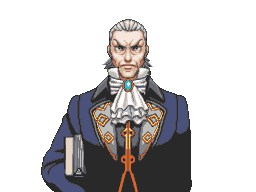
Not to mention, a lot of the deal with Manfred is that his actual character, in a lot of facets, is used to fuel motivations of other characters. He’s the opposing force for Gregory Edgeworth in the past which was needed for his murder, his involvement with DL-6 caused Miles Edgeworth to live with him and eventually set himself down the road to becoming a prosecutor. His involvement with DL-6 is what eventually (non-intentionally) led Mia Fey into law. His role as a prosecutor is used to be the “final boss” for Phoenix for the fourth case. The man’s actions reverberate throughout the original trilogy and beyond, in a lot of respects, but there’s not much to him beyond the need for a perfect record and a calculating, cold megalomaniac.
His child, on the other hand, bears a few of those characteristics along with a lot of time to grow beyond them into her own staple of the series. I’m talking, of course, of Franziska von Karma.
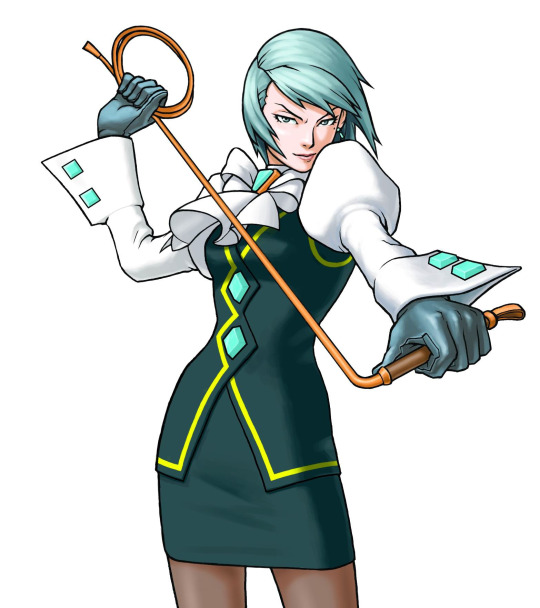
You ever wonder if she ever intends to....draw blood? No? Just me?
You liars.
The Design
So I’ve spent the last few times talking less and less about the actual facets of her design, so I think it’d do to try and fix that. First off, let’s see her silhouette.

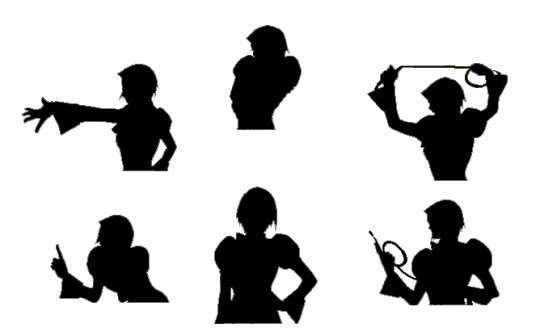
A lot of the best parts about Franziska’s design is the lively actions she is able to produce in court. This is mostly due to including the whip into the picture. The whip is one of the most important parts of her design, both due to her character and due to the added action poses it can create. If a character can be defined by the tool they use, that’s a very good thing to consider when designing their poses. You can tell that, when you take the whip out of the equation, you’re still able to tell who she is in a list of Ace Attorney characters, but it’s not as clear if you throw other franchises in.
A lot of times, an external item like a weapon is almost as integral as a piece of clothing for a character. Of course, relying entirely on that for a character’s design isn’t prudent, as the weapon needs to be integral to the design. For example, if Link from the Legend of Zelda series were to not have a sword available, the clothing is still very distinctly him. The hood in particular is almost instantly recognizable, even with every other feature blacked out. And, forgive me, but even the Master Sword is still just a sword to a silhouette.
However, we look at Samus from the Metroid series, we end up having two ‘states’ of Samus. One with her Power Suit on and one without. (I count the Power Suit as a weapon, fight me) With her Power Suit, she is the same Samus we know, who is able to go into the unknown and fight whatever comes her way but without it, not only does the silhouette change but the actual gameplay changes. She can’t go in and fight aliens the same way without her weapon. The lack of her suit makes the encounters she faces more aligned on the side of cautionary, because she can’t deal with space pirates and monsters the same way as if she did have her suit.
Lot of talk to amount to “her whip is important”, huh? It’s a very distinct trait for her design that speaks of her character. She’s aggressive and wishes to dominate her opponent with nothing short of perfection in her case. She uses it to force her will through the court. She uses it for “reward” once with Detective Gumshoe, too. (poor Gumshoe)

When you look at her design, you can see that there are elements of Manfred in her. Compared to Phoenix, her design is more regal looking with a nice big bow and a stylish suit. Her gray hair masks her actual age, to the point that you’d have to hear it from her to find out that she’s actually a young prodigy. Her posture intimidates in court, with animations ripped from her father, yet her fragile ego causes her to lose her cool very fast, which includes a few distraught emotions in her sprites.
She builds up a cool facade with her whip and her dressed-to-impress confidence that she attempts to exude. To her, the impression she leaves is most important, which makes sense because have you ever gotten hit by a whip? She cares about the mark that’s made and aims to make sure her presence is known. And to a passerby, that is exactly what happens, because outside of context she looks like a very scary lady who will absolutely dominate you, in court.
Franziska is obsessed with perfection and control, even moreso than her father was. This is due to having not one, but two individuals she has to live up to. She lives up to her father in terms of name, but she must also live up to her “little brother” Edgeworth in terms of legacy.
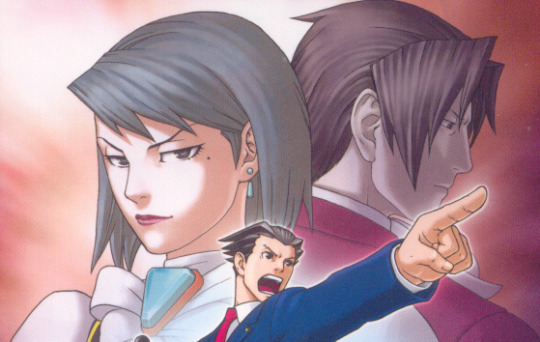
Legacy
Now obviously when I say “legacy”, I bet you would say “but wouldn’t she get that from her father, as well?” Well, only tangentially. I personally believe that Edgeworth left a more lasting impression on her character than her father, and it’s mostly due to Mr. Phoenix Wright.
See, Franziska grew up with her father’s shadow looming overhead. To be anything short of the genius prosecutor that Manfred was would be considered a blight to her name. So she focused her energies on doing so, even though she personally admitted to herself that she’d never get to the same level of genius as her father. Still she studied and persisted, earning herself the title of “the Prodigy”.
Soon enough she heard of her father’s defeat at the hands of Phoenix Wright, but that alone did not set her off. In fact, she couldn’t care less about her father’s defeat. It was learning that the defendant was Edgeworth, then finding out that Phoenix had already beaten him twice before despite HIS perfect record, and then learning of Edgeworth’s disappearance (Prosecutor Miles Edgeworth chooses death) that set her off on her travels to Japanifornia.
Because she wasn’t facing against Wright for revenge of her father. She was going to prove herself against someone that Edgeworth lost to.
When I think of a “legacy” character, I consider a character that has a torch passed down to them, much like a family line of superheroes. In some ways they retain the same spirit as those who came before them, but they have their own spirit about them. Take, for example, DC Comics icon - and man with most elaborate basement under parents’ house - Batman. A few years back when Bruce Wayne had “died”, Dick Grayson took up the mantle of Batman. While Bruce was more stoic and cold in his style, Dick was more loose in his demeanor. He cracked more smiles and was more talkative. More relaxed. He couldn’t replicate Batman himself, despite how many years he studied under him as Robin, because he realized that he couldn’t do so. He instead took his own take and, depending on who you ask, succeeded in doing the role justice. He lacked confidence as Batman but was more than able to fulfill the role as Gotham City’s protector regardless.
Why I find legacy characters fascinating is the little bits of what is brought from the past into the role of the present and how that can mix well, can clash with other elements, and even be forgotten. Even Edgeworth did this, to an extent, when he was the antagonist of the first game. You didn’t know it until the fourth case, but everything that Edgeworth did was due to what was displayed to him by his teacher, Manfred. Winning at any cost. He sets that aside after the first game and finds his own path as a prosecutor, yet he still retains some elements of his mentor, such as his outfit’s similarities to Manfred’s and his posture when at the bench. Naturally, some elements would have to stay because of his iconic design, but even 7 years later in Dual Destinies, Edgeworth is still using the same posture, and his big change is that he also has an unbuttoned coat and wears glasses out of court.
So going back to Franziska, her main motivator for Justice for All is to “defeat Phoenix Wright”. She goes through the same methods as her father before her, but also took in Edgeworth’s forwardness in understanding the entire case, no matter the absurdity. She studied the Kurain Channeling Technique and even introduced it in the second case in order to prove that, even with something supernatural like channeling spirits which is beyond normal law, Maya would have still done the deed and is still guilty under law. She puts up a potentially damaging photo for her prosecution just to back Phoenix in a corner. In the third case she focused her energies on making sure Phoenix wasn’t getting any evidence she didn’t know about, which ended up costing her the case when she forced Acro out of the room before he could dispose of the murder weapon. And in the time she was involved in prosecuting the final case, she made explicitly sure that Adrian Andrews knew that she didn’t have to testify.
All of this was to defeat Phoenix Wright, who had inadvertently brought himself up as a target for all of her ire. The one who defeated her father and adoptive brother before her. All to stoke her ego.
But, of course, she didn’t.
Try as she did, she wasn’t able to defeat Phoenix. She got shot on the way to court to the fourth case and had to let Edgeworth do the job for her. Even then, she took it upon herself to get the decisive evidence to court just in time to give Edgeworth the win. Finally, Phoenix lost and it was because of her!
And yet, when Phoenix was so happy even after losing his first case (for a reason she didn’t know), she broke. She didn’t understand why he was so happy about it. She tossed her whip aside and left for the airport, to fly far away.
But then Edgeworth came to her with her whip. He spoke to her about what he found out on his trip. About how win records were meaningless. About how Manfred was wrong, and how a prosecutor’s job is to find the truth. She was still a prosecutor, but if she wanted to give up, then he would continue forward and leave her behind.
Handing the whip back to her was an important gesture, because as mentioned, the whip is a symbol of control. When she had it, she had always felt like she was in control of her situation. It was much like a security blanket for her. Handing it back after she tried to toss it away signifies that Edgeworth understands that prosecution is important to her and she needs to find her own path forward like he did.
Telling her that she’d be left behind is also important. It may have been cruel, but Franziska is a character who went through all that effort to overcome her own faults in order to try and surpass those who came before her. She was obsessed with it, in order to stoke her own ego, but she wouldn’t be able to do so if she gave up. Edgeworth knew she didn’t want to do that. She still needed someone to fight against, and being the doting little brother that he is (still like 7 years older), he took it upon himself to stoke that fire again.
And she vowed, in a show of sobbing emotion, that she would return and defeat Phoenix Wright and to become a better prosecutor than he.
Franziska is a great character even though her role as a prosecutor was done because the designers didn’t want to have Edgeworth continue to lose fights due to his popularity. She was brought in as a flawed and fixated prosecutor to further the prosecutor’s role as an antagonist while solidifying that which Edgeworth had proven before; that the prosecution is merely an antagonist, not a villain.
Her emotional weight is believable and sympathetic. Her personality in court is perfect for the role of making you detest her because of how many times she’s able to one-up Phoenix (you) as you go through the cases. And yet her overall character is someone you can’t help but feel for once it’s all over. She’s in a dogged pursuit of proving herself as better than those before her, and Phoenix (you) proves to be an obstacle she can’t overcome.
After Justice for All, she learns to pursue her goals for herself and not for any legacy she was supposed to inherit. She works with Interpol and assists Edgeworth in his own games, but she hasn’t seen much action since. Now that we know what Maya’s been up to in Spirit of Justice, I really want to see what Franziska has been up to in the years since next.
I want to know if she sued Larry for the use of her likeness in his children’s book, “Franzy's Whippity-Whip Trip“.
Conclusion

Wow, she’s tipping Gumshoe $5. That’s probably the nicest thing she’s ever done for him.
Even though her inclusion was the designer’s intent to keep Edgeworth from losing all the time, Franziska was a worthy entry in this series as an antagonist. Her flaws helped elevate her as an egomaniac that eventually made you empathize with where she’s coming from. She’s not perfect and can’t be the same level as what her father was, but that’s exactly what makes her such a good character.
Because true perfection doesn’t exis-
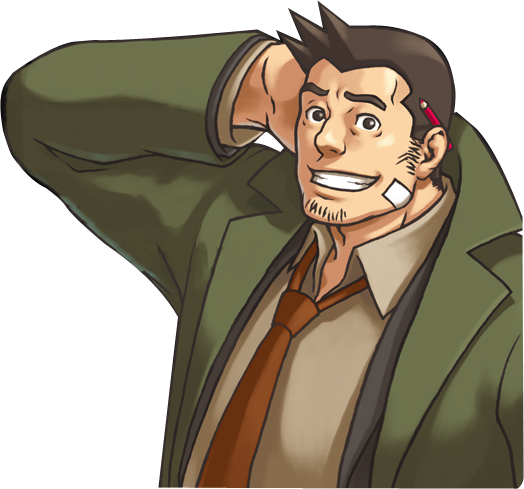
Okay, stop that. Get outta here.
Thank you very much for reading. It was fun to look more into Franziska and remind myself why I really like her. Most of these thoughts are just my thoughts, of course, so if you have any thoughts about her yourself, let me know!
Until next time...
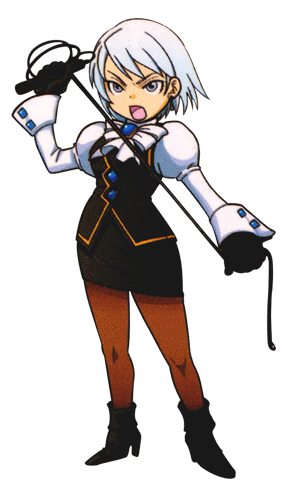
You foolish fools.
#Turnabout Design#Ace Attorney#Franziska von Karma#Blog#Ace Attorney: Justice for All#Phoenix Wright Ace Attorney: Justice for All
30 notes
·
View notes